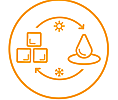
Document IIF
Tuyauterie remplie de PCM pour le conditionnement d’air dans les bâtiments déjà construits.
PCM-filled piping for the air conditioning of existing buildings.
Numéro : 0042
Auteurs : FRIEDRICH T.
Résumé
A system consisting of decentralized heat storage is presented. The units work multifunctionally by being used as storage and for distributing thermal energy. The newly developed elements consist of a slim metal tube that is filled with PCM for optimal heat storage. The storage is loaded with a time delay using renewable energy. The temperature difference in the outside air is used daily or weekly for efficient storage. The temperature of the collected energy must be below the switching point of the PCM. If this constellation does not exist, the temperature is changed by using a thermoelectric heat pump based on Peltier elements. This means the required temperature is always reached.
The switching point of the filled PCM corresponds to the desired room temperature. The constant temperature level ensures optimal air conditioning of the buildings. The tubes used are also suitable for energy distribution. The surface of the tube is suitable for releasing energy via radiation. The shell arranged around the tube serves as a converter to specifically increase performance through convection. The air is generated by fans arranged in the shell.
Documents disponibles
Format PDF
Pages : 8 p.
Disponible
Prix public
20 €
Prix membre*
Gratuit
* meilleur tarif applicable selon le type d'adhésion (voir le détail des avantages des adhésions individuelles et collectives)
Détails
- Titre original : PCM-filled piping for the air conditioning of existing buildings.
- Identifiant de la fiche : 30032394
- Langues : Anglais
- Sujet : Technologie
- Source : 14th IIR Conference on Phase-Change Materials and Slurries for Refrigeration and Air Conditioning. Proceedings: Paris France, May 29-31, 2024.
- Date d'édition : 31/05/2024
- DOI : http://dx.doi.org/10.18462/iir.pcm.2024.0042
Liens
Voir d'autres communications du même compte rendu (40)
Voir le compte rendu de la conférence
Indexation
-
Thèmes :
Frigoporteurs diphasiques (MCP, coulis de glace…);
Conditionnement d'air pour le confort;
Efficacité energétique, économie d'énergie;
Stockage d'énergie thermique;
Autres systèmes de production de froid (dessiccation, thermoélectricité, thermoacoustique...);
Techniques des pompes à chaleur - Mots-clés : Énergie renouvelable; Conditionnement d'air; PCM; Stockage d'énergie thermique; Échangeur de chaleur; Effet Peltier; Froid thermoélectrique; Pompe à chaleur
-
Descripción y análisis del uso de un depósito d...
- Auteurs : REAL FERNÁNDEZ A., NAVARRO-ESBRÍ J., BARRAGÁN-CERVERA A., et al.
- Date : 03/05/2016
- Langues : Espagnol
- Source : CYTEF 2016. VIII Congreso Ibérico y VI Congreso Iberoamericano de las Ciencias y Técnicas del Frío, Coimbra-Portugal, 3-6 mayo, 2016.
- Formats : PDF
Voir la fiche
-
Recharge demand mitigation for latent heat ther...
- Auteurs : OTHMAN H. A. al-, AUTE V., TANCABEL J.
- Date : 15/07/2024
- Langues : Anglais
- Source : 2024 Purdue Conferences. 8th International High Performance Buildings Conference at Purdue.
- Formats : PDF
Voir la fiche
-
High power thermal energy storage research at L...
- Auteurs : WORLITSCHEK J., FISCHER L. J., STAMATIOU A.
- Date : 21/05/2018
- Langues : Anglais
- Source : 12th IIR Conference on Phase-Change Materials and Slurries for Refrigeration and Air Conditioning. Proceedings: Orford, Canada, May 21-23, 2018.
- Formats : PDF
Voir la fiche
-
A study into optimal design of an air-PCM therm...
- Auteurs : HLINIK J., KLIMES L., CHARVÁT P., et al.
- Date : 21/05/2018
- Langues : Anglais
- Source : 12th IIR Conference on Phase-Change Materials and Slurries for Refrigeration and Air Conditioning. Proceedings: Orford, Canada, May 21-23, 2018.
- Formats : PDF
Voir la fiche
-
Numerical simulation of the charging process in...
- Auteurs : MOUSAVI AJAROSTAGHI S. S., PONCET S., DOLATI A., et al.
- Date : 21/05/2018
- Langues : Anglais
- Source : 12th IIR Conference on Phase-Change Materials and Slurries for Refrigeration and Air Conditioning. Proceedings: Orford, Canada, May 21-23, 2018.
- Formats : PDF
Voir la fiche
